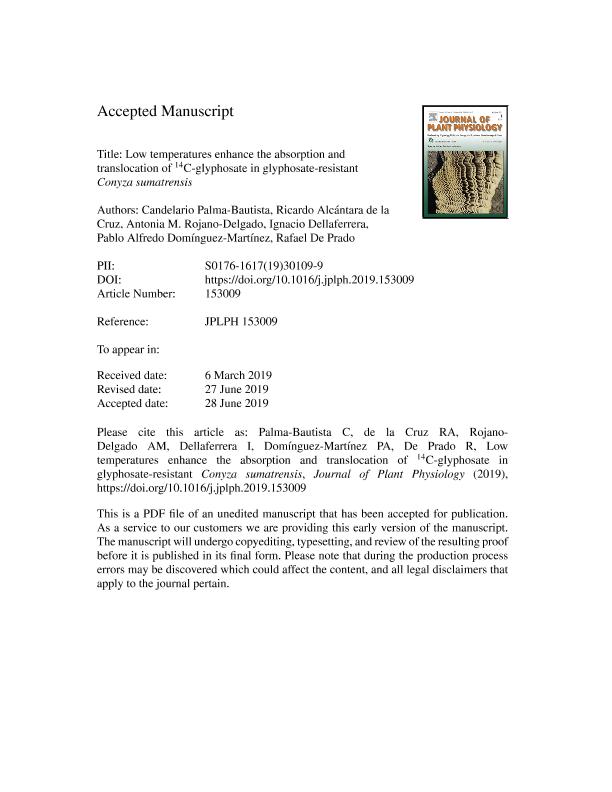Artículo
Low temperatures enhance the absorption and translocation of 14C-glyphosate in glyphosate-resistant Conyza sumatrensis
Palma Bautista, Candelario; Alcántara de la Cruz, Ricardo; Rojano Delgado, Antonia María; Dellaferrera, Ignacio Miguel ; Domínguez Martínez, Pablo Alfredo; De Prado, Rafael
; Domínguez Martínez, Pablo Alfredo; De Prado, Rafael
 ; Domínguez Martínez, Pablo Alfredo; De Prado, Rafael
; Domínguez Martínez, Pablo Alfredo; De Prado, Rafael
Fecha de publicación:
09/2019
Editorial:
Elsevier Gmbh
Revista:
Journal of Plant Physiology
ISSN:
0176-1617
Idioma:
Inglés
Tipo de recurso:
Artículo publicado
Clasificación temática:
Resumen
Influence of low temperatures on the glyphosate efficacy was studied in glyphosate-resistant (R) and -susceptible (S) Conyza sumatrensis biotypes.For this purpose, the physiological and enzymatic aspects involved werecharacterized under two growing temperature regimes [high (30/20 oC) andlow 15/5oC temperatures day/night]. The R biotype was 5.5 times moreresistant than the S biotype at high temperatures; however, this R-to-S ratio decreased to 1.6 at low temperatures. At 96 h after treatment (HAT), theshikimic acid accumulation was higher in the S biotype in both temperatureregimes (4.6 and 1.9 more shikimic acid at high and low temperatures,respectively), but the accumulation of the R biotype increased 2.6 times at lowtemperatures compared to high ones. From 24 to 96 HAT, the 14C-glyphosateabsorption ranged from 28 to 65% (percentage reached from 48 HAT) at lowtemperatures and from 20 to 50% at high temperatures (gradual increase), butthere were no differences between C. sumatrensis biotypes within eachtemperature regime. At high temperatures, the 14C-glyphosate translocationwas different between biotypes, where the R one retained at least 10% moreherbicide in the treated leaves than the S biotype at 96 HAT. So, the S biotypetranslocated 40% of 14C-glyphosate absorbed to roots, and the R biotypetranslocated only 28% of herbicide at the same period. At low temperatures,there were no differences between biotypes, and at 96 HAT, the 14C-glyphosate found in treated leaves was ~47% and up to ~42% reached the roots, i.e., the resistance mechanism was suppressed. The basal and enzymaticactivities of the 5-enolpyruvyishikimate 3-phosphate synthase were differentbetween temperature regimes, but there was no differences between biotypeswithin each temperature regime, showing that target-site resistancemechanisms did not contribute in the glyphosate resistance of the R biotype.Low temperatures enhanced the absorption and translocation of glyphosate bysuppressing the resistance mechanisms improving its efficacy on resistantplants. This is the first characterization about the role of temperatures in theglyphosate efficacy on C. sumatrensis.
Archivos asociados
Licencia
Identificadores
Colecciones
Articulos(CCT - SANTA FE)
Articulos de CTRO.CIENTIFICO TECNOL.CONICET - SANTA FE
Articulos de CTRO.CIENTIFICO TECNOL.CONICET - SANTA FE
Citación
Palma Bautista, Candelario; Alcántara de la Cruz, Ricardo; Rojano Delgado, Antonia María; Dellaferrera, Ignacio Miguel; Domínguez Martínez, Pablo Alfredo; et al.; Low temperatures enhance the absorption and translocation of 14C-glyphosate in glyphosate-resistant Conyza sumatrensis; Elsevier Gmbh; Journal of Plant Physiology; 240; 153009; 9-2019; 1-28
Compartir
Altmétricas



